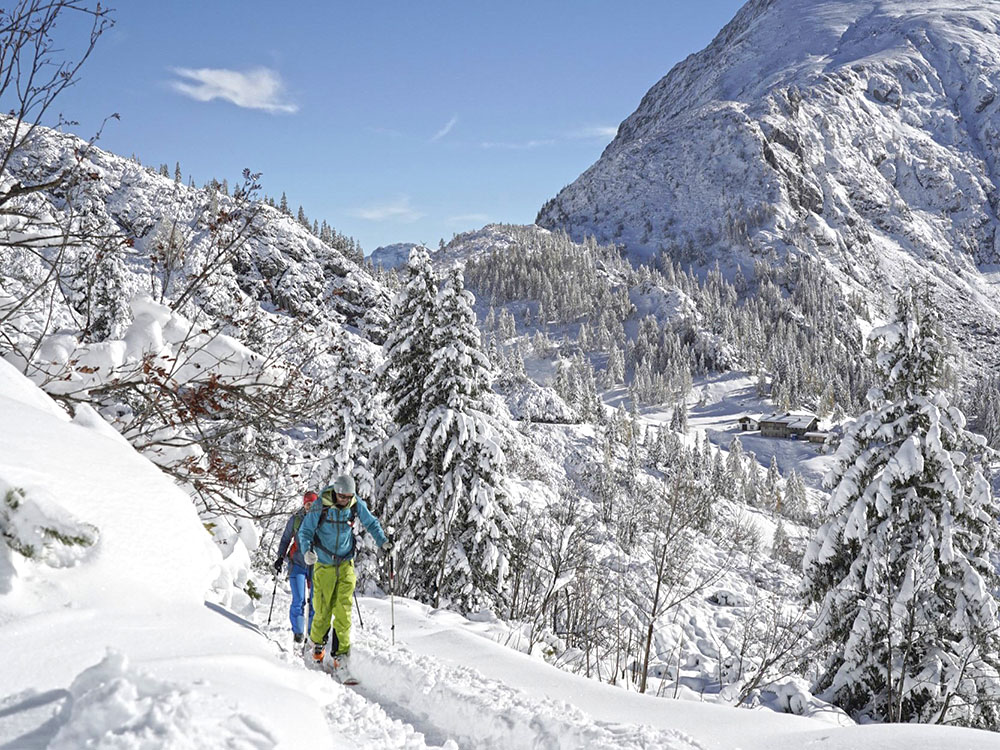Ski and snowshoe tours
A large part of the trail network in Berchtesgaden National Park is located in alpine terrain and is not accessible in winter without special equipment and alpine experience.
If you would like to explore the National Park in winter, we recommend taking part in one of our guided hikes from the winter program. In alpine terrain, we recommend that visitors are accompanied by a certified mountain guide!

If you are out and about on skis, snowboard or snowshoes, there are a few things you should be aware of:
Forest-wildlife sanctuaries, route recommendations and more!
Forest-wildlife conservation areas were designated as part of the DAV project “Environmentally friendly ski mountaineering”, in cooperation with the State Ministry for the Environment and Consumer Protection and the Bavarian State Office for the Environment. At the same time, nature-friendly ski and snowshoe routes were developed for the entire Bavarian Alpine region. The DAV campaign “Naturally on Tour” now communicates the results of the project. Here in the national park, too, there are some forest-wildlife conservation areas - and a whole host of great ski and snowshoe routes that have been tested for nature compatibility and avoid the conservation areas. You can see where these are on the map.
And why all this?
Wild animals in the Alps have a particularly hard time in winter. In order to survive the cold and food shortages, they have to conserve as much energy as possible. They are therefore dependent on very specific wintering areas. The route recommendations and forest-wildlife sanctuaries help to avoid disturbing wild animals in these areas - because even if we don't see them, energy-intensive flight reactions can occur!

DAV tips for nature-friendly ski touring, freeriding and snowshoeing
- Respect protected and conservation areas for plants and animals, avoid noise.
- Observe markings* and instructions, e.g. the route recommendations of the DAV campaign “Naturally on Tour”.
- Recognize and avoid habitats, only observe wild animals from a distance, stay away from wildlife feeders, keep dogs on a lead.
- In high winter: Avoid summits, ridges and crests before 10 am and after 4 pm. Generally avoid tours in the dark (exceptions: “tour evenings” or long spring tours with an early start).
- In wooded areas and at the tree line, stay on the usual ski and snowshoe routes, forest and hiking trails, keeping a sufficient distance from groups of trees and shrubs.
- Protect reforestation and young forests.
- Travel in an environmentally and climate-friendly way: use public transport or carpool, use designated parking spaces, do not block access roads, pay parking fees.
- Prefer stays of several days to frequent day trips, use the local gastronomic offerings, inform yourself about the nature and culture of the destination region.
- Plan tours primarily with guides, maps and portals that carry the DAV seal of approval “Naturally on Tour” (e.g. Alpine Club Maps BY Bayerische Alpen, www.alpenvereinaktiv.com).
- Observe the ten “DAV rules for ski tours on pistes”.
* In the field, these signs help to avoid stress for wild animals in particularly important habitats.
You can find out more about nature-friendly ski and snowshoe tours and forest-wildlife sanctuaries from the DAV: alpenverein.de/natürlich-auf-tour
Please note: You move in unsecured alpine terrain at your own risk. You must be aware of alpine dangers yourself, especially the risk of avalanches. No liability is assumed.
Avalanche warning service Bavaria
Tour suggestions
Winter
Please note that the level of difficulty may vary depending on the tour portal and your personal perception of difficulty may differ. Adapt your tour planning to your physical and mental abilities and take all factors into account (e.g. distance, altitude, slope gradient, current conditions in the terrain, etc.).
Help to protect the sensitive mountain nature!
In a national park, the protection of nature is the primary goal. And for this to work, we need your help! Please adhere to the following rules to protect chamois, marmots and co:
- Take garbage back home with you
- Do not pick plants
- Keep dogs on a lead in the national park
- Stay on the paths - please do not walk cross-country or take shortcuts
- Do not disturb wild animals
- Do not camp or bivouac
- Do not light campfires
- Do not make noise
- Air mattresses, rubber boats and other flotation devices are prohibited
- Drones are not allowed to fly in the national park
- Cyclists must show consideration for hikers
Thank you for your understanding and for taking part!





